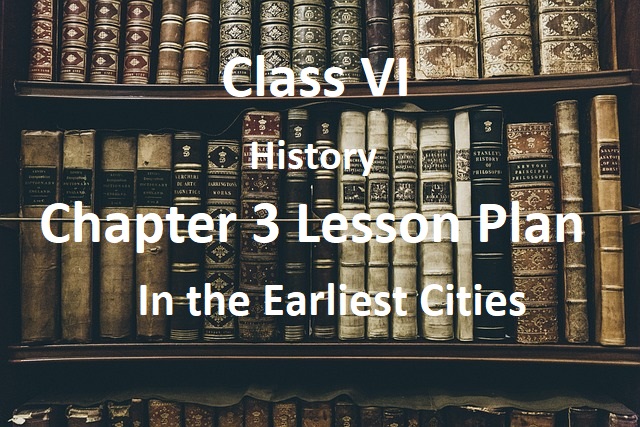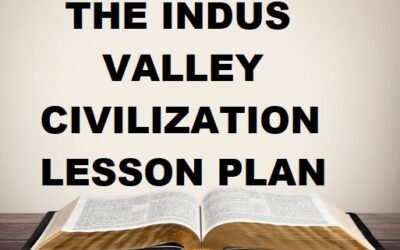Class VI History Chapter 3 Lesson Plan
History class VI Chapter 3 Lesson plan is an activity that a teacher has to perform before the actual teaching takes place. It is the road map for any teacher. Moreover, effective lesson planning provides the students with the necessary structure and direction. It also takes care of the diverse needs of our students. Class VI History Chapter 3 Lesson plan provides better resources that are integral to students. This lesson plan of class VI is full of classroom activities that children will enjoy doing. It will also allow teachers to critically reflect on and improve our teaching and learning practice. It ensures every minute of class time in teaching new concepts. Class VI History Chapter 3 lesson plan will help you to reach every child with a clear plan in mind.
Class VI History Chapter 3 Lesson Plan in the Earliest Cities
Topics covered:
History
Chapter 3. : In the earliest cities
______________________________________________________________________________________________
In the Earliest Cities
General Objective:
Firstly, to develop students’ interest in the subject.
Secondly, to understand society and its place within it.
Thirdly, developing scientific temperament among the students.
Fourthly, to develop skills of inquiry, investigation, and analysis.
Finally, to enhance students’ learning ability.
Class VI History Chapter 2 Lesson Plan – As Per NCF
Specific Objective:
- Students will know how Harappa was found.
- They will also learn about the two parts of Harappa city.
- Finally, Students will also understand the similarities between the Harappan cities and contemporary cities.
Checking Previous Knowledge:
At first, the teacher checks the previous knowledge of the students by asking a few questions.
Introducing Topic:
At first, the teacher introduces the topic by asking basic questions like:
Teacher: Do you live in a single house or a multistoried building?
Student’s response: single house, flats (varied responses)
Teacher: How many floors are there in the building you live in?
Student’s answer: 3, 5, 10 (varied responses)
Teacher: Do you have a bathroom with proper drainage?
Student’s answer: yes.
Teacher: Do you think that in ancient cities also people used bathrooms with proper drainage?
Student’s answer: yes / No
Teacher: Can you name some ancient cities in India?
Student’s answer: Delhi, Ujjain, Nalanda, Patliputra, Calcutta.
Teacher: Have you heard about Harappa and mohenjo daro?
Students: No response.
Statement of Topic
O.K. So, today we are going to read about the two ancient cities of India – Harappa and Mohenjo Daro.
In the Earliest Cities
Introducing Topic: storytelling method
One day few people were moving and digging around the Indus river.
After digging for some time, they found something very strange.
They all were surprised.
Do you know what did they find?
They found big size bricks under the earth.
Therefore, they continued digging and found that it was a drain made from strong bricks for flowing of water.
Do you know who the people digging were and what they were called?
They are called archeologists.
They study human history and prehistory through the physical remains found under the earth.
So, they continued digging.
But, the more they dig, the more they were finding surprising things.
This time they found actual pieces of clothes, silver vases, stone statues, and copper objects.
With these objects, they could conclude that perhaps these are the remains of an old city.
Can you now guess the name of these old cities?
They were Harappa and Mohenjo Daro.
Perhaps the oldest cities in the world around 7000 years ago.
Teaching aids:
Text Book, Black Board, Youtube videos, Images, and PPT
Technique:
To begin with, the teacher starts the Interactive session with common examples.
However, the teacher uses various methods to make the topic interesting by interacting with the children in the class.
By asking very simple questions, the teacher draws the attention of the class.
Also, make sure that the children are involved in the discussion.
Finally, While interacting with the students, the teacher also tells about Harrapan and Mohenjo Daro sources.
Class VI History Chapter 1 Lesson Plan: What, Where, How and When – Activity Based
Class VI History Chapter 3 Lesson Plan in the Earliest Cities
Content/ Teaching Points:
- The story of Harappa.
- What was special about these cities?
- Houses, drains and streets.
- Life in the city.
- New crafts in the city.
- In search of raw materials.
- Food for people in the cities.
- Harappan towns in Gujarat
- The mystery of the end.
First Activity:
Open Book Assessment
The teacher conducts an open-book test.
To begin with, she Prepares 10 short questions (worksheet) from the chapter.
However, Students are asked to find out the answers from the textbook and write in their copy.
Time: 30 minutes.
Second Activity:
Subjects Integrated: Art, Geography, and Science.
Description:
Firstly, the teacher divides the class into four groups.
Thereafter, each group is given a topic from the chapter, such as
- i) Architecture,
- ii) Life in the city,
iii) Art and Craft,
Group members have to read the topic from the book and provide information based on the given topic.
They will be given 20 minutes time to collect information and 3 minutes time to present.
Finally, their observations will be displayed on the class board for two days.
Learning Objective:
By the end of the activity, students will be able to:
- describe the architecture of the House, streets, and drainage.
- explain Life in the city,
- provide detailed information about Art and crafts, and
- mark the Harrapan towns in Gujarat on the map of India.
Assessment Criteria:
Indicators
- Relevance of Content
- Presentation of information gathered
- Awareness of the information gathered
- Creativeness
- Analytical Skills
Classwork:
- i) Firstly, Objective and short answer type questions will be done.
- ii) Finally, Long answer type questions will be discussed and done in the class.
Home-work:
Draw the design of buildings, streets and drains of Harappan period and compare with today’s town planning.
Values imparted:
Firstly, the Social responsibility for proper drainage and management of water.
Secondly, Sensitization towards the advantage of a planned town.
Multidisciplinary Integrated learning:
- Art: Draw a scene of Harappan town showing streets and drainage system.
- English: T.V. reporting from Lothal. (imagine you are in Lothal)
- Math: what is the advantage of streets and drains at 90 degrees?
Assessment Criteria:
Indicators
- Relevance of Content
- Presentation of information gathered
- Awareness of the information gathered
- Creativeness
- Analytical Skills
Learning Outcome:
After the completion of this chapter, students will be able to
- Firstly, explain the topic how people started growing crops.
- Secondly, discuss about source of History.
- Thirdly, sketch out the information we get from ancient sources and
- Finally, find facts about growing seeds, taming animals and discovering fire.
Remedial Measure:
Pair and share
Children sitting on the left side of the row will explain the chapter to the children sitting on their right.
Class VI History Chapter 3 Lesson Plan in the Earliest Cities
Conclusion:
I hope You will find Class VI History Chapter 3 Lesson plan of great help. Here in this Class VI History Chapter 3 Lesson plan, we have included only single chapter from History. We have tried to keep our lesson plan teacher and student-friendly. I Hope, this Class VI History Chapter 3 Lesson plan caters to the need of every child. Students will love performing these activities which will make the class lively and interesting.
As a teacher, if you have conducted any interesting classroom activity, do write to me so that I can include it in my Class VI History Chapter 3 Lesson plan.
If any teacher wants to write a guest post can mail it to me. Your article will be published in your name with your photograph on my website.
You may like to read other popular posts:
Class VI Civics Chapter 2 Lesson Plan
Class VI Geography Chapter 2 Lesson Plan – Detailed, Interactive and Child Centric





0 Comments